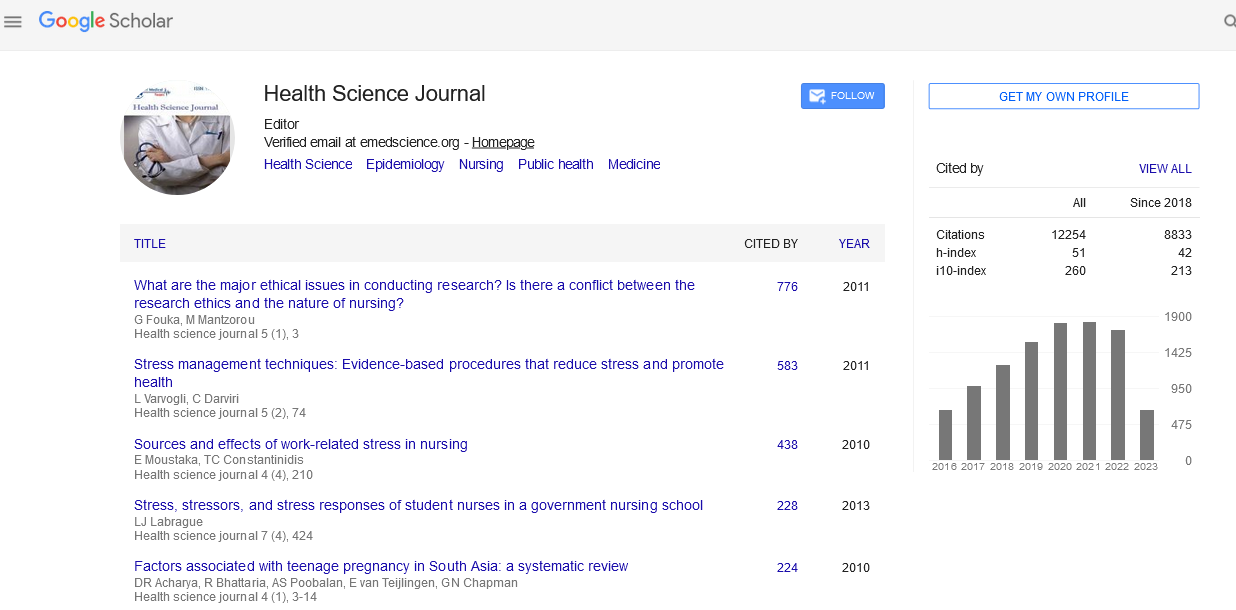Perspective - (2025) Volume 19, Issue 2
Can the 21-Gene Recurrence Score be the Decisive Tool for Safely Omitting Radiotherapy in Breast Cancer Treatment?
Fadila Kouhen*,
Hanae El Gouach,
Meriem Damou and
Mohammed Sqalli Houssaini
Department of Oncology, Mohammed VI University of Sciences and Health, Casablanca, Morocco
*Correspondence:
Fadila Kouhen, Department of Oncology, Mohammed VI University of Sciences and Health, Casablanca,
Morocco,
Email:
Received: 28-Mar-2024, Manuscript No. IPHSJ-24-14709;
Editor assigned: 02-Apr-2024, Pre QC No. IPHSJ-24-14709 (PQ);
Reviewed: 16-Apr-2024, QC No. IPHSJ-24-14709;
Revised: 21-Feb-2025, Manuscript No. IPHSJ-24-14709 (R);
Published:
28-Feb-2025, DOI: 10.36648/1791-809X.19.2.1230
Abstract
The idea clinical trial presented at the esteemed San Antonio breast cancer symposium and simultaneously published in the journal of clinical oncology sheds light on a specific subset of breast cancer management. This singlearm study included 200 postmenopausal patients (aged 50-69) with pT1N0 invasive breast cancer, ER-positive, PRpositive, HER2-negative and an Oncotype DX score ≤ 18. Following Breast Conserving Surgery (BCS) with margins ≥ 2 mm, patients were enrolled to explore radiotherapy omission, given they consented to at least 5 years of endocrine therapy. The primary endpoint was the 5-year locoregional recurrence rate post-BCS. Conclusively, the IDEA trial indicates effective high disease control at 5 years without radiotherapy.
Keywords
Breast cancer; Radiotherapy; Treatment
Introduction
Of the 186 patients with a follow-up duration of at least 56 months, both overall survival and breast cancer–specific survival rates at 5 years were 100%. The 5-year freedom from any disease recurrence was 99% (95% Confidence Interval (CI)=96%-100%). Within the 5-year period, two patients experienced events: One had an isolated ipsilateral axillary recurrence at 21 months and the other had an ipsilateral breast event at 49 months.
Six patients experienced recurrence after the 5-year mark following breast-conserving surgery. Among these, five had ipsilateral breast events, while one had both an ipsilateral breast event and a regional recurrence. No distant recurrences were reported. When considering the entire follow-up period, the crude rates of ipsilateral breast events were 3.3% (2 of 60 patients) for those aged 50 to 59 years and 3.6% (5 of 140 patients) for those aged 60 to 69 years. The crude rates of overall recurrence were 5.0% (3 of 60 patients) and 3.6% (5 of 140 patients), respectively.
Nevertheless, upon a more comprehensive examination of its outcomes and implications, the study at hand confronts several noteworthy challenges that warrant thorough consideration and shape its interpretative landscape.
Firstly, the single-arm design of the study, lacking a control group, coupled with a relatively modest sample size of 200 postmenopausal patients, hinders the ability to make direct comparisons and draw definitive conclusions regarding the efficacy of radiotherapy omission [1].
Moreover, the relatively short 5-year follow-up period may not capture late recurrence events, especially in these patients with a life expectancy surpassing 10 years. A longer follow-up duration might be necessary to thoroughly assess the safety implications of omitting radiotherapy.
Otherwise, the primary aim of this study was to assess the safety of omitting adjuvant radiotherapy in young postmenopausal patients. However, a notable limitation arises from the study's composition, which predominantly includes older individuals. With patients aged 50-60 years constituting less than 30% of the cohort and a median age of 62 years, the representation skews towards the older demographic. This imbalance hinders the study's capacity to draw robust conclusions regarding recurrence rates in younger populations.
Description
Interestingly, the study explored using the 21-gene recurrence score alongside traditional criteria to identify younger postmenopausal breast cancer patients who might safely omit radiotherapy. While its established role in guiding chemotherapy decisions is recognized, its potential to identify a subset of patients suitable for omitting radiotherapy remains an area warranting further exploration. The ongoing DEBRA trial, a phase III clinical trial focused on de-escalation of breast radiation for conservative treatment of stage I, hormone-sensitive, HER-2 negative cases with an oncotype recurrence score ≤ 18, exemplifies the evolving landscape of research in this area. This trial seeks to provide valuable insights into the potentialomission of radiotherapy in specific patient subsets based on their oncotype recurrence score [2].
Additionally, a notable observation centers around the study's requirement for surgical margins of 2 mm or wider following Breast Conserving Surgery (BCS). This specification diverges from contemporary guidelines that emphasize achieving a "no ink on tumor" margin for invasive cancer surgeries. Such a deviation prompts inquiries regarding the congruence of the study's methodology with prevailing standard protocols. This incongruity could introduce uncertainties regarding the reliability and applicability of the study's outcomes in the context of modern clinical practice and guideline adherence.
The independent correlation of Lymphovascular Invasion (LVI) with a negative prognostic impact on Overall Survival (OS), Disease-Free Survival (DFS) and Metastasis-Free Survival (MFS) in early breast cancer patients is a notable finding [3]. However, the study acknowledges that the rate of positive LVI did not surpass 8%, emphasizing a potential limitation in the generalizability of this observation to populations with higher LVI prevalence.
Recently, the five-year findings from the sound trial mark a significant advancement in breast cancer treatment strategies [4]. The study supports the omission of Sentinel Lymph Node Dissection (SLND) for breast cancer patients with tumors up to 2 cm and negative preoperative axillary ultrasonography, challenging traditional practices. Key to this approach is the mandatory inclusion of adjuvant radiotherapy, casting doubt on the notion of omitting radiotherapy for these patients.
Conclusion
It is also important to note that given the complexities and challenges related to non-compliance and complications in endocrine therapy treatment, choosing to exclude either it or adjuvant radiotherapy requires careful examination. In this context, The EUROPA trial aims to compare endocrine therapy with radiation monotherapy in older women with early-stage breast cancer, adding valuable insights to tailor treatment strategies.
Finally, we believe that this single-arm study sets the stage for a phase III trial with a control group and a broader patient sample to further evaluate the potential utility of the 21-gene recurrence score in guiding radiotherapy decisions for postmenopausal breast cancer patients.
References
- Jagsi R, Griffith KA, Harris EE, Wright JL, Recht A, et al. (2024) Omission of radiotherapy after breast-conserving surgery for women with breast cancer with low clinical and genomic risk: 5-year outcomes of IDEA. J Clin Oncol 42: 390-398.
[Crossref] [Google Scholar] [PubMed]
- Houvenaeghel G, Cohen M, Classe JM, Reyal F, Mazouni C, et al. (2021) Lymphovascular invasion has a significant prognostic impact in patients with early breast cancer, results from a large, national, multicenter, retrospective cohort study. ESMO Open 6: 100316.
[Crossref] [Google Scholar]
- Gentilini OD, Botteri E, Sangalli C, Galimberti V, Porpiglia M, et al. (2023) Sentinel lymph node biopsy vs. no axillary surgery in patients with small breast cancer and negative results on ultrasonography of axillary lymph nodes: the sound randomized clinical trial. JAMA Oncol 9: 1557-1564.
[Crossref] [Google Scholar] [PubMed]
- Meattini I, Poortmans PM, Marrazzo L, Desideri I, Brain E, et al. (2021) Exclusive endocrine therapy or partial breast irradiation for women aged ≥ 70 years with luminal A-like early stage breast cancer (NCT04134598–EUROPA): Proof of concept of a randomized controlled trial comparing health related quality of life by patient reported outcome measures. J Geriatr Oncol 12: 182-189.
[Crossref] [Google Scholar] [PubMed]
Citation: Kouhen F, El Gouach H, Damou M, Houssaini MS (2025) Can the 21-Gene Recurrence Score be the Decisive Tool for Safely Omitting
Radiotherapy in Breast Cancer Treatment?. Health Sci J Vol.19 No.2





